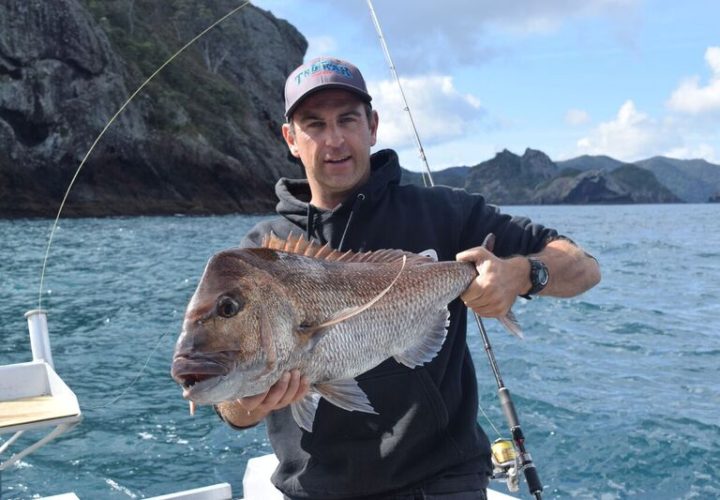Lately there is hardly a week goes by without discussion in the media about the state of our fish stocks. Taking out all the bullshit coming from some interested parties in these discussions and doing a fair bit of reading between the lines, it would seem that in some areas of the country fish stocks certainly aren’t that great. Taking into account the daily costs of going fishing e.g. fuel, tackle, bait, lures, plus all the general costs of keeping a boat up to scratch, it seems only logical to keep the fish you do catch in prime eating condition. Of course you can always go and buy fish, but with snapper fetching up to NZ$42 a kilo and the uncertainty of just how fresh it is, if you are able to catch your own very fresh fish with all the fun that involves, it seems a much better option to me. Catching the fish is one thing. Looking after the ones you are going to return to the sea or as importantly the ones you are going to keep requires some finesse if you want to keep the fish in good condition.
Iki Spike
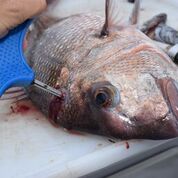
This little tool is first in line to keep your catch in top eating quality. They can be bought at any tackle shop (Kilwell make a great little Iki Spike) or if you like, you can fashion one out of an old Philips screwdriver. It’s basically a thin steel shaft with a handle. If you have caught a nice plump healthy snapper and are keeping it to eat, before taking the hook out drive the iki spike into the fishes brain killing it instantly. The brain on a snapper is about 20mm above and behind the eye, you will know when the brain has been pierced, as the fish will go ridged and the tail will curl up.
You can now simply remove the hook from a dead unmoving fish, easy. I have seen many people using a fillet or bait knife for this purpose, I have also seen the results of a greasy hand slipping down the blade when trying to iki fish with a knife, its not pretty. Simple answer don’t use knifes for this job. A fish killed instantly with an iki spike suffers a lot less stress and put on ice will always taste better than a fish left to die slowly in an open bin out in the sun.
Coolers
Coolers come in all shapes and sizes and in a big price range. Many fishermen tend to go for the longer style bins rather than square as fish fit into these better. As for size, something in the 50 to 90 litres range seems to suit most boats and catch limits. Cost is a whole different ball game If you regularly just go out for a few hours then you can possibly get away with a cheaper brand, but if your out all day or even overnighting for a couple of days then your going to need a bin of a much higher quality with far superior insulation.

There are many good brands out there that are ideally suited to the recreational fisho, that are almost commercial in build, but they will keep your fish cold for days on end. They also make a great extra seat if needed and are well worth the money.
Salt Ice
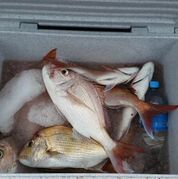
Ice made with salted water freezes at a much lower temperature than fresh water, therefore it takes longer to melt. Because of this salt content and lower temperature it is the perfect ice to chill down fish, keeping that just caught freshness locked in. There are a few ways to achieve this. After loosening up the ice put a thin layer along the bottom of the bin, then lay your fish on it, after that cover your catch with another layer of ice, if you’ve had a real good day, repeat the process with more fish then more ice.
The second method is to grab half a bucket of salt water straight out of the ocean and pour it into your chilly bin, then shake out a bag of loose ice into the bin turning the water and ice into a slurry and place your fish into this. Salt slurry cools fish down very quickly, setting the flesh and keeping it very fresh and safe to eat.
Filleting
Having fish well chilled down and the flesh nice and firm makes the job of filleting so much easier. I will quite often leave my catch on ice overnight, and fillet them the following day if time allows. Firm flesh comes off a fish frame a lot easier than unchilled fish, which is quite rubbery when fresh. Although it may sound strange the most dangerous knife is a blunt knife. Your fillet knives should be razor sharp. Sharp blades go through firm flesh like hot butter, making the filleting process a lot simpler, they will take the fillet off cleanly and leave very little flesh on the fish frame.
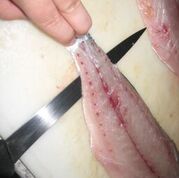
Trying to force a blunt knife through a fish is when nasty accidents can occur, so keep your knives really sharp.I put my fish frames, skin, and gut in a plastic bag and put them straight into the freezer. Then I either dump them at sea next time I am out fishing, or in the bin on rubbish day, it keeps every thing clean and tidy with no smell.
Releasing Fish
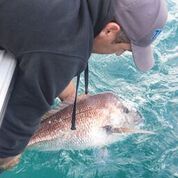
Releasing fish is more than simply removing the hook and tossing them back from whence they came. A little care is important, whether the fish is undersize, or you need to put it back because you have your quota. I often put back big snapper as the old ones don’t really taste as good as the youngies. Lets assume you have had a good day, and a good feed is in the chilly bin but the fish are still biting and there’s the odd big one in the school so you want to keep fishing and having fun.
This is where the art of releasing fish safely so they will survive comes in. If your not using them already you will now need to switch to recurve or circle hooks, these hooks will generally always hook up in the corner of the jaw making them easy to remove with little damage to the fish. Striking with this type of hook isn’t really necessary, as these hooks naturally roll into the corner of the fish’s mouth when it takes the bait. If your using lures like softbaits, or slow jigs these also tend to always hook up in the mouth or lips, so again are easy to remove. One tool you will find invaluable for removing hooks is pair of long nosed pliers. You may want to shout yourself a good pair of stainless ones, but a cheep pair of steel ones from your local hardware store will do the job. You will just have to clean and oil them after each use that’s all. A good trick is to use these pliers to flatten down the barb on the hooks making them really easy to remove, just keep a good steady pressure on the rod and you wont loose to many fish. Most fish have a protective slime coating on the outside of their skin. Holding fish with your bare hands removes this coating allowing bacteria to penetrate its skin and making the fish susceptible to disease. Far better to use wet cotton gloves or hold the fish about to be released with a wet cloth or small wet towel. If you lay the fish on a wet towel or cloth while the hook is removed – covering the fish’s eyes often helps to calm it down. If you must touch the fish make sure your hands are wet or use a wet cloth or wet gloves between you and the fish. Never touch a fish’s gills, they are extremely delicate and just touching them can damage them.
If you hold the fish by the base of the tail and under the head with wet hands, you will do he least damage the fish. Never, ever, not even once, lift a fish out of the water by holding the belly area. You will almost certainly damage internal organs. It reduces survival chances dramatically. Using a net to land fish for releasing also takes the pressure off them, and if you bring a big one to the surface, try not lifting it into the boat but use the pliers to remove the hook while it lies quietly alongside the boat.
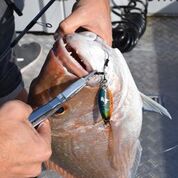
There are some excellent nets available now, with the soft flexible rubber ones, minimises fish stress and tangled hooks. Rough, hard netting will remove slime and scales from the fish, which is its natural protection against parasites and infection. Should you want some photos of your big fish and who wouldn’t, just remember this fish is probably exhausted after a long fight so will need looking after really well if you wish to release it to survive. The faster you can get a fish to the boat the better its chances of survival. The longer the fight the less chance the fish has of surviving. Get it back into the water ASAP and make sure it swims away strongly, those big ones are our breeders and our grandkids will be sure pissed off if we kill all them off, leaving few for there fishing days in the future. Never throw a fish back but gently hold it in the water until it finds the energy to swim away on its own.
BAROTRAUMA
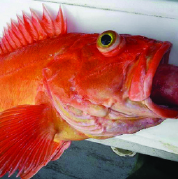
One major problem that can occur when pulling big fish up out of deep water too quickly is that the gasses in the fishes swim bladder do not have time to release or equalise. This causes an over inflation of the swim bladder, and this pressure can then cause the stomach to protrude from its mouth and sometimes pushing intestines out of its rear vent. It is impossible to release a fish in this condition, so what do you do.Small legal fish might as well be kept for the table, but if it’s a big breeding snapper and you really want to put it back, then there is a way.
The tool you will need is a hypodermic needle and syringe, lay the fish on a wet towel, remove the plunger from the syringe and at a forty five degree angle slide the needle under the fish scales and into the swim bladder. then place a wet hand onto the fishes stomach and very gently push down. If you have done everything correctly you should hear air being dispelled through the syringe and the fishes stomach should disappear back down its throat to where it belongs. This isn’t an easy process but it does work and allow that big breeder to live another day. Try googleing barotrauma fish release / how to vent a fish. Another easier way is to take a very heavy sinker 20 to 30oz attach it to your main line then tie a short light trace to the sinker with a sprat hook on the trace. Push the sprat hook through a tiny amount of the snappers lip skin then carefully place the fish in the water and very very slowly lower it to the bottom, after about five minuets allowing the swim bladder gasses to re adjust, with a sharp rip of the rod remove the small hook and the fish is free. I have heard several accounts of this working I hope it does.
Protecting Our Prized Resource
I strongly believe the fish around our coastal waters belong to the people of New Zealand, and recreational fishermen should be first in line with the commercial fishing sector taking a back seat. I’m sure this political hot potato will be fought long and hard into our fishing future so in the meantime take care and look after your edible catch for it’s a very prized resource.


